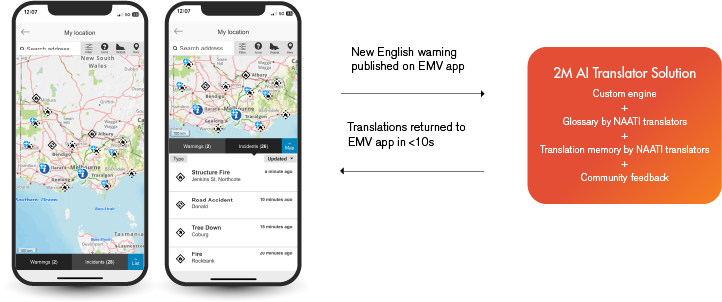- Home
- Resource Center
- Articles & Videos
- Could AI Translation Become the Norm in Emergency Management Communication?
3 June 2024
Could AI Translation Become the Norm in Emergency Management Communication?
In times of crisis, delivering clear, concise, and in-language communication can significantly impact the effectiveness of emergency response efforts.
In the past, emergency management communication in Australia has fallen short due to lack of access to timely and up to date in-language information, leaving individuals vulnerable, uninformed, and unable to take appropriate actions during critical moments.
What if I told you that AI has the power to eliminate risk from human hands? To save lives?
This blog explores what AI translation is, how human translators and AI can collaborate, case studies of AI translation in action, and future considerations for the question: could AI translation become the norm in emergency management?
Current landscape
22% of the Australian population speaks a language other than English at home. Australia’s diversity shows no signs of slowing down. Neither do natural disasters.
The population impacted by natural disasters reached record highs in recent years, according to analysis from KPMG, which shows that almost 18 million Australians living in a LGA were impacted by at least one natural disaster in 2022.
Number of natural disasters
| STATE | 2019 BUSHFIRES | 2022 STORMS | 2022 FLOODING |
|---|---|---|---|
| Queensland | 3,853,000 | 5,282,000 | 2,602,000 |
| New South Wales | 2,995,000 | 7,603,000 | 6,454,000 |
| Victoria | 1,195,000 | 4,640,000 | 4,120,000 |
| South Australia | 237,000 | 69,000 | 4,000 |
| Tasmania | 23,000 | 281,000 | 34,000 |
| Western Australia | 4,000 | 59,000 | 294,000 |
| Northern Terrirotory | - | 29,000 | 69,000 |
Source: KPMG
With the rate and intensity of natural hazards expected to increase alongside increasing diversity, it’s important that Australia’s warning systems are prepared and capable of distributing in-language messages and alerts quickly and to large-scale audiences.
Take note of past mistakes
Non-English-speaking communities are typically more at-risk during emergencies or disasters, often relying on people within their communities for information. This can result in misinformation due to misunderstandings of official advice.
Federal and State Governments across Australia were slashed for “laughable” and “nonsensical” translations of COVID-19 information. Said translations caused confusion and eroded trust in government advice. In this case, failure to meet diverse health communication needs led to more hospitalizations and worse health outcomes among non-English-speaking populations.
It doesn’t stop there. During the 2011 Queensland floods, the Ethnic Communities Council of Queensland (ECCQ) reported that “the absence of translated messages during the flood resulted in many CALD communities not taking heed of warning messages, underestimating the risks to which they were exposed, and therefore not taking appropriate action”.
Translating emergency alerts by engaging NAATI-certified translators ensures non-English-speaking individuals can receive alerts in their native language. Engagement comes from going a step further and delivering information through the correct channels and to meet the needs and demands of Australia’s diverse population.
Every disaster and emergency is time sensitive. AI can enable instant alerts, at scale, and in many languages.
Human-AI collaboration
Human input is critical to the success of AI translation. While AI translation speeds up turnaround times, it lacks cultural awareness to ensure messages resonate with target communities. Human translators maintain cultural knowledge to ensure translations are culturally attuned and appropriate.
At the Australian LSP 2M Language Services, human translators play an important role in the AI translation process. In complex and nuanced situations like emergency responses, human translators provide insights into cultural sensitivities and norms that AI might not fully grasp.
How it works
Human input drives the quality of AI translation. AI translation systems work off large datasets curated by human translators. Integrating humans into the AI translation workflow enables feedback to continuously improve AI translation quality over time.

The diagram shows how human translators contribute to the AI translation process. Human input serves to validate the translation output that the AI model produces. Any rectifications or approval is fed back into the AI model for future application.
What scenarios are best suited to AI translation?
AI translation can be used to quickly communicate critical information and alerts with the public. Think public health emergencies, natural disasters, onsite construction and/or mining emergencies.
For example, Emergency Management Victoria (EMV) has an app called VicEmergency, which currently delivers emergency information and alerts to 3.7 million users.
Since 2022, we at 2M Language Services have been working with EMV in support of the multilingual version of the app, VicEmergency Plus. The app was built as a pilot to test the viability of automated translations of a trained engine and improve accessibility. Every time an alert was triggered in the app, AI translated the text. The “AI translator” was trained off a large dataset of previously translated and EMV-approved translations, curated by NAATI-certified translators and community members from each language.

"You have one new message"
AI translation can help to disseminate urgent messages quickly on various platforms. It’s crucial to communicate via the channel that the community prefers to ensure the greatest reach and engagement.
Here are some channels that can integrate AI translation to keep communities informed and engaged:
Mobile apps: Like the VicEmergency Plus app, mobile apps can integrate AI translation to provide up-to-date alerts and safety information with non-English-speaking users in their native language.
Social media: Social media is a great way to disseminate rapidly changing information with large audiences, especially if younger generations are part of your target audience. A survey by Deloitte found that 65% of 18- to 24-year-olds (Gen Z) and 61% of 25- to 34-year-olds (millennials) list one or more social media as their preferred source of news.
Emergency hotlines: AI translation can break down language barriers between operator and caller. In the case of emergency hotlines, speech-to-speech translation works to ensure operators and callers can have a conversation in their respective native language. Speech-to-speech translation relays the speech in real-time to the receiver and vice versa.
Text and email: Text and email are widely used to communicate emergency information and can be used to disseminate information quickly and efficiently.
Putting AI to good use
Increasing demand and need for greater access to time-critical emergency communication in Australia reveals an opportunity for AI translation. Adopting AI for emergency messaging promotes community safety, action, and resilience. However, the success of AI translation lies in the quality of the data it receives. Therefore, there is an ongoing need for collaboration between linguists, technologists, emergency response specialists to understand and implement best-practice use of AI translation in emergency scenarios.

Rhian Ferguson
Rhian Ferguson, Communications Manager at 2M Language Services (2M), manages strategic communication plans that enhance brand visibility and foster meaningful connections with stakeholders. Rhian is passionate about driving positive brand sentiment and loyalty through impactful and consistent messaging. At 2M, Rhian spearheads marketing initiatives that focus on secure technology and AI to enhance in-language support during emergencies in the health, mining, and community sectors.


